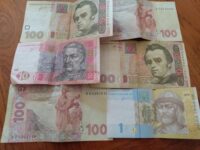Ukraine celebrates the 29th anniversary of the hryvnia, its national currency.
 To mark 29 years of Ukraine’s hryvnia, introduced to the world on September 2, 1996, we revisit a four-part radio series originally aired five years ago on Nash Holos Ukrainian Roots Radio.
To mark 29 years of Ukraine’s hryvnia, introduced to the world on September 2, 1996, we revisit a four-part radio series originally aired five years ago on Nash Holos Ukrainian Roots Radio.
This series explores how coins and banknotes quietly tell stories—of independence, identity, and a long, intertwined history shaped by centuries of shared struggles for independence and sovereignty by both nations.
They aren’t just pieces of paper and metal—they’re miniature monuments to historical memory.
🪙 Part 1: Sovereignty in Print
What do a medieval coin and a biblical shekel have in common? Turns out, quite a lot. Both made a comeback in the 20th century—one in Eastern Europe, the other in the Middle East—as symbols of national rebirth.
In 1996, five years after Ukraine gained independence from the Soviet Union, the hryvnia quietly entered circulation. Its launch was anything but ordinary, however. It was designed in Canada, printed in Malta and the UK, and kept under wraps until the big reveal. The secrecy wasn’t just practical—it was symbolic. Reviving the name in the 20th century was both a nod to history and a deliberate act of cultural reclamation. The modern hryvnia linked Ukraine’s post-Soviet independence to its ancient roots, asserting continuity with a time when Kyiv was a thriving center of commerce and power.
Israel’s currency story began decades earlier, in 1948, when the newly declared Jewish state inherited the Palestine Pound—a leftover from British colonial rule. Replacing it with the Israeli pound, and later the shekel, was ultimately a statement of identity, resilience, and continuity with its own ancient history. The shekel, mentioned frequently in the Bible, carried deep spiritual and cultural significance—making its revival a powerful symbol of restored sovereignty.
Both countries chose names steeped in heritage: the hryvnia, echoing the silver ingots of Kievan Rus’; the shekel, drawn from biblical times. These currencies were cultural declarations, minted with pride and layered with meaning.
🧑🎨Part 2: Portraits of Legacy — The First Four Faces
Before diving into the portraits featured on Israeli currency, I want to share a note about the research behind this series. In producing these episodes, I undertook a thorough and meticulous deep dive into the history of Israel and Palestine, as well as into the lives and legacies of Jewish figures born in Ukraine.
Along the way, I encountered historical records that diverge sharply from what’s commonly presented in mainstream media and on university campuses about Israel’s history. Much of what’s widely accepted today is incomplete, distorted, or shaped by political agendas.
This series doesn’t aim to provoke, but to illuminate. By grounding each episode in historical fact and cultural context, I hope to offer a more nuanced understanding of the shared heritage and complex realities that have shaped both Ukraine and Israel.
In Part 2 of this series, we explore how Israeli currency pays tribute to Jewish icons whose roots trace back to Ukraine. More than merely historical figures, these cultural architects helped shape the soul of modern Israel.
Imagine holding a banknote that features someone born in your hometown—someone who helped shape a nation. That’s the case for many Israelis whose currency features prominent Jewish historical figures born in Ukrainian lands. They include:
- Hayim Nahman Bialik – Born in Zhytomyr, Bialik became Israel’s national poet. His writing captured the emotional and spiritual struggles of Jewish life in Eastern Europe and helped define Hebrew literary tradition.
- Ze’ev Jabotinsky – A native of Odesa, Jabotinsky was a fiery Zionist leader, journalist, and translator. His vision of Jewish self-defense and national pride left a lasting imprint on Israeli politics.
- Levi Eshkol – Born in Oratov, Eshkol served as Israel’s third Prime Minister. He oversaw major infrastructure development and played a key role during the Six-Day War.
- Golda Meir – Born in Kyiv and raised in the United States, Meir immigrated to Palestine in 1921 and later became Israel’s first female Prime Minister. Her steely resolve and diplomatic acumen made her one of the most recognizable leaders of her time.
Each of these figures appears on Israeli banknotes not just for their achievements, but for the symbolic weight they carry—Ukrainian-born Jews who helped build a new nation while carrying the legacy of their birthplace.
🧑🎨 Part 3: Portraits of Legacy — The Second Four Faces
The series continues with four more Ukrainian-born Jewish luminaries whose portraits grace Israeli currency. Their contributions span literature, science, and statecraft, each adding a unique thread to Israel’s cultural tapestry.
- Moshe Sharett – Born in Kherson, Sharett was Israel’s second Prime Minister and a skilled diplomat. He helped shape Israel’s foreign policy during its formative years.
- Shmuel Yosef Agnon – From Buchach, Agnon was a Nobel Prize-winning author whose modernist Hebrew prose bridged tradition and innovation.
- Yitzhak Ben-Zvi – A native of Poltava, Ben-Zvi was Israel’s second president and a historian who documented Jewish communities across the diaspora.
- Saul Tchernichovsky – Born in Mikhailovka (now Zaporizhia Oblast), Tchernichovsky was a poet and translator who brought classical and European literature into Hebrew, enriching its expressive range.
These portraits remind us that the story of Israel is also, in part, a story of Ukraine. And that a legacy born of shared subjugation has become a partnership of equals—defending independence and modeling peaceful co-existence in a truly multicultural state.
🏛️ Part 4: Ukraine’s Tribute in Coin
In the final episode, the spotlight returns to Ukraine. The hryvnia has a longer history than most realize—first appearing briefly in 1918, then re-emerging in 1992 before becoming Ukraine’s official currency in 1996. It has circulated through revolutions, invasions, and everyday survival. Remarkably, it also features Jewish figures—an acknowledgment of Ukraine’s complex, often painful past. The four Jewish figures featured in Part 4 lived through Soviet persecution, war, and exile—each leaving a legacy now reflected on Ukraine’s currency.
Among those honoured:
- Sholem Aleichem – The “Jewish Mark Twain,” whose Tevye inspired Fiddler on the Roof
- Lev Landau – Nobel-winning physicist and Kharkiv academic
- Ilya Mechnikov – Immunologist and pioneer of gerontology
- Zhovkva Synagogue – A Renaissance-era architectural gem
One of the most poignant tributes came in 2017, when Ukraine issued a commemorative banknote echoing the 1917 karbovanets. It featured four languages—Ukrainian, Polish, Russian, and Yiddish—reflecting a time when multiculturalism wasn’t just an ideal, but a lived reality.
🧭 Summary: A Shared Story Etched in Currency
When I first put together this series for Nash Holos, I didn’t expect coins and banknotes to reveal so much. But they did—about independence, identity, and the historical ties between the Ukrainian and Jewish nations. From the secretive birth of the hryvnia to the portraits of Ukrainian-born icons on Israeli currency, each episode uncovered a layer of history I hadn’t seen before.
As Ukraine marks 29 years of the hryvnia, I invite you to listen, reflect, and maybe even look at the banknotes in your own wallet a little differently. Because sometimes, the smallest things carry the biggest stories.
📬 Reflect, Share, Connect
If this story sparked a memory or made you think differently about currency, I’d love to hear from you. Leave a comment below or join the conversation on social media using:
#Hryvnia29 #HryvniaHistory #UkrainianJewishHeritage #NashHolosRadio #Ukraine
Thanks for reading, for listening, and for being part of this journey through history, heritage, and shared humanity.


